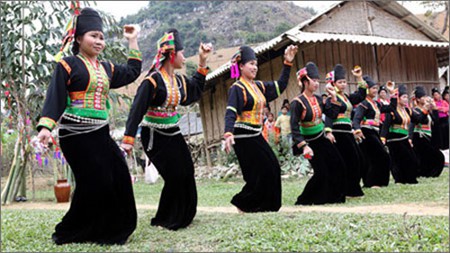Despite living a hard life in remote mountain areas, the Kho Mu have a rich cultural life that includes many musical genres. The most popular is Tom singing.
The Kho Mu sing anytime and anywhere, but especially at happy of the family and community events.
They sing “Tơm Đường Kmun” at wedding ceremonies, “Tơm Ơ Grang Mỵ” while building a house, “Tơm Kun chơ” at hamlet festivals, and “Tơm Muôn” at the New Year festival to welcome spring.
They sing when they are working in their terraced fields and when they are relaxing, when they are lonely, and when young boys and girls want to express their romantic feelings.
In daily life the Kho Mu sing either without a musical instrument or accompanied by a vertical pan-pipe called a Pí Tơm.
Hoang Thao, a researcher of ethnic music said, “The music and lyrics of Tom singing are not written out by songwriters. The singers improvise lyrics for each circumstance to express their happiness, sadness, wishes, and dreams. When they are sad, they sing to sublimate their feelings.”
Tom songs are often about Kho Mu history, the happiness and hardship of their life, or the love they feel for their family and hamlet.
Young boys and girls sing to express their feelings. Folklorist Vi Văn An of the Vietnam Museum of Ethnology says,“Tom singing has rules. The singers can modify the tones and lyrics according to their experience and improvisation ability. Old songs are about history, epics of heroes, and the merits of the village founders. In daily life, they often just improvise.”
Tom songs are transferred verbally from generation to generation. Folklorist Vi Van An said fewer young Kho Mu are able to sing Tom because of cultural dilution and the influence of new art forms. The state should encourage the Kho Mu to teach Tom singing to their children to preserve it for the community.




